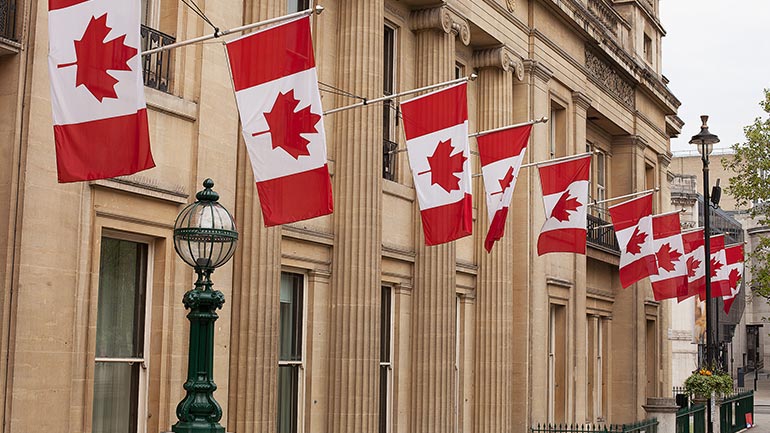Could U.S. Resilience Derail the Bank of Canada in 2024?
By: Robert Both
May 10, 2024 - 5 minutes 30 seconds
The Bank of Canada (BoC) continues to inch closer to its first rate cut, with recent data showing clear downward momentum across measures of core inflation and further easing of labour market conditions. But the lack of similar progress in the U.S. has raised questions around how far the BoC can move if a stronger U.S. economy keeps the Fed on hold longer than expected. We do not expect U.S. resilience to have a significant impact on the timing of the first BoC cut, but do see limits to how far the BoC can stray from the Fed without putting inflation progress at risk. Using history as a guide, we believe the BoC can diverge from the Fed by at least another 50bps before rate differentials and a softer loonie start to play a larger role in the BoC's deliberations.
What Does History Tell Us?
The BoC has shown its ability to diverge from the Fed for extended periods of time, but that divergence has mostly been limited to a 75-100bp spread between the BoC's overnight rate and upper-bound of the Fed Funds target rate since the early days of the BoC's inflation mandate. The BoC operated 100bps below the Fed for most of the period leading into the Financial Crisis, and we saw a 75bp divergence between the two central banks from 2010-15 and 2017-18. We have also seen larger dislocations between the BoC and Fed in 2003 and 2008, but these episodes came in the context of positive CAN-US spreads, and we see them as less relevant for 2024-25. We do not assign much weight to larger policy divergences from the late 1990s either. That leaves 100bps as the key resistance point for the BoC undershooting the Fed, which we expect to be reached by the September 2024 fixed announcement date.
100bps Has Market a Point of Resistance for BoC/FedDivergence
Not a Binding Rule
We do not see a 100bp gap between the BoC and the Fed as a binding constraint, with our base case running up against this level for most of 2024H2 and 2025, but the BoC's tolerance for divergence will ultimately boil down to its assessment of domestic economic conditions and USDCAD's sensitivity to rate differentials over 2024.
We believe the BoC will be able to ease at least 50bps before it potentially faces this dilemma, and in our base case for rate cuts to start in July, that would suggest that continued resilience in the U.S. economy is unlikely to derail the BoC before October. In a scenario where stronger U.S. economic conditions force the Fed to stay on hold beyond September (not our base case), it would introduce upside risk to our forecast for USDCAD to hit 1.41 by Q4 given the historic sensitivity to front-end rates. That would leave the BoC balancing the risks of further CAD depreciation on a rate cut to 4.25% or holding rates unchanged at 4.50% to support the currency and give more time for the Fed to catch up.
Holding rates at 4.50% in October would also keep monetary policy more restrictive heading into what the BoC knows will be a very challenging year for fixed-rate mortgage renewals, with $235bn of 5 year mortgages set to reset from an average rate of 2.4%. Governor Macklem recently warned the BoC could be underestimating the impact that previous rate hikes will have on mortgage renewals. Should the next six months provide the BoC with more evidence of financial stress across the household sector then the BoC might conclude that rate cuts are necessary to prevent inflation from undershooting the 2% target, even with the Fed on hold.
Schedule of Fixed Rate Mortgage Renewals
When Does USDCAD Start to Bite?
From a macro perspective, there is a high bar for currency developments to get the BoC's attention, and an even higher bar for them to trigger a response. We do not see any specific level that will trigger a BoC response but note that 1.40 has served as important psychological barrier in the past, and we would expect a move towards 1.45 to be met with more scrutiny from BoC officials.
There is some precedent for the 1.45 level touching a nerve at the Bank of Canada, most notably in early 2016 when West Texas Intermediate (WTI) prices were nearing their trough. Two weeks before the January 2016 meeting BoC Governor Poloz gave a speech at the Mayor's Breakfast Series in Ottawa on Canada-U.S. policy divergence (coming right after the first Fed hike), where he made the following comment:
It’s possible to imagine a situation where a sharply weaker currency could drive a country’s inflation significantly above target, even with the continued presence of excess capacity in the economy. The greater the divergence of inflation from target, the more skeptical people might become that the divergence would be temporary. In other words, there could be a risk that inflation expectations would become de-anchored.
— Stephen Poloz, Former Governor of the Bank of Canada (Speech, 2016)
USDCAD rose from 1.41 to 1.46 between that speech and the January policy decision, and Governor Poloz pointed to those currency headwinds as a key factor in the BoC's deliberations after it held rates unchanged. That was echoed in the January 2016 Monetary Policy Report, which cited the risk "that passthrough may be greater than expected based on historical experience."
CAD Depreciate Already Contributing to Higher Import Prices
Does History Still Rhyme?
Not all lessons from 2016 will apply in 2024; the Bank is not currently facing a terms-of-trade shock, and energy prices will not provide the same offset to imported goods should USDCAD continue to grind higher into 2025. That may leave the BoC more hesitant to diverge sharply from the Fed, especially after three years of inflation running above the inflation target and before inflation expectations have fully normalized. Lastly, it should be noted the pace of change in USDCAD is as important as the level. A hypothetical move above 1.40 will be less concerning for the BoC if it happens gradually.
Overall, we see a high threshold for USDCAD to derail the Bank of Canada's easing cycle and believe the Bank can ease by 50bps regardless of the Fed's near-term path. If the Fed stays on hold longer than expected, a move below 4.50% will hinge on the sensitivity of USDCAD to front-end rates along with the evolution of domestic economic conditions into 2025.
Subscribing clients can read the full report, Could U.S. Resilience Derail the Bank of Canada in 2024?, via the TD One Portal






